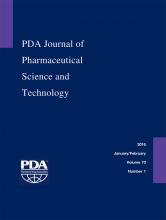Abstract
A feasibility study was conducted for a sensitive and robust dye immersion method for the measurement of container closure integrity of unopened prefilled syringes using fluorescence spectrophotometry as the detection method. A Varian Cary Eclipse spectrofluorometer was used with a custom-made sample holder to position the intact syringe in the sample compartment for fluorescence measurements. Methylene blue solution was initially evaluated as the fluorophore in a syringe with excitation at 607 nm and emission at 682 nm, which generated a limit of detection of 0.05 μg/mL. Further studies were conducted using rhodamine 123, a dye with stronger fluorescence. Using 480 nm excitation and 525 nm emission, the dye in the syringe could be easily detected at levels as low as 0.001 μg/mL. The relative standard deviation for 10 measurements of a sample of 0.005 μg/mL (with repositioning of the syringe after each measurement) was less than 1.1%. A number of operational parameters were optimized, including the photomultiplier tube voltage, excitation, and emission slit widths. The specificity of the testing was challenged by using marketed drug products and a protein sample, which showed no interference to the rhodamine detection. Results obtained from this study demonstrated that using rhodamine 123 for container closure integrity testing with in-situ (in-syringe) fluorescence measurements significantly enhanced the sensitivity and robustness of the testing and effectively overcame limitations of the traditional methylene blue method with visual or UV-visible absorption detection.
LAY ABSTRACT: Ensuring container closure integrity of injectable pharmaceutical products is necessary to maintain quality throughout the shelf life of a sterile drug product. Container closure integrity testing has routinely been used to evaluate closure integrity during product development and production line qualification of prefilled syringes, vials, and devices. However, container closure integrity testing has recently gained industry attention due to increased regulatory agency scrutiny regarding the analytical rigor of container closure integrity testing methods and expectations to use container closure integrity testing in lieu of sterility tests in stability programs. Methylene blue dye is often used for dye ingress testing of container closure integrity, but we found it unsuitable for reliable detection of small breaches in prefilled syringes of drug product. This work describes the suitability and advantages of using a fluorescent dye and spectroscopic detection for a robust, sensitive, and quality control–friendly container closure integrity testing method for prefilled syringes.
- © PDA, Inc. 2016
PDA members receive access to all articles published in the current year and previous volume year. Institutional subscribers received access to all content. Log in below to receive access to this article if you are either of these.
If you are neither or you are a PDA member trying to access an article outside of your membership license, then you must purchase access to this article (below). If you do not have a username or password for JPST, you will be required to create an account prior to purchasing.
Full issue PDFs are for PDA members only.
Note to pda.org users
The PDA and PDA bookstore websites (www.pda.org and www.pda.org/bookstore) are separate websites from the PDA JPST website. When you first join PDA, your initial UserID and Password are sent to HighWirePress to create your PDA JPST account. Subsequent UserrID and Password changes required at the PDA websites will not pass on to PDA JPST and vice versa. If you forget your PDA JPST UserID and/or Password, you can request help to retrieve UserID and reset Password below.






